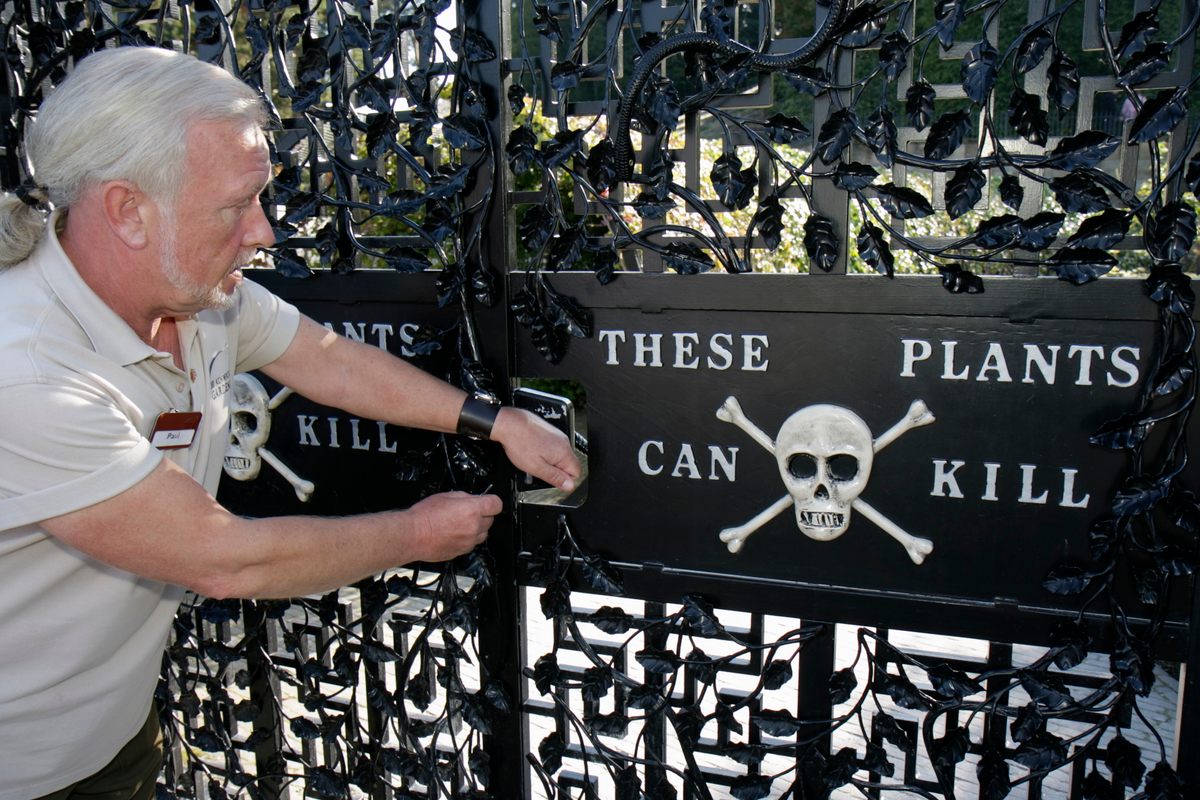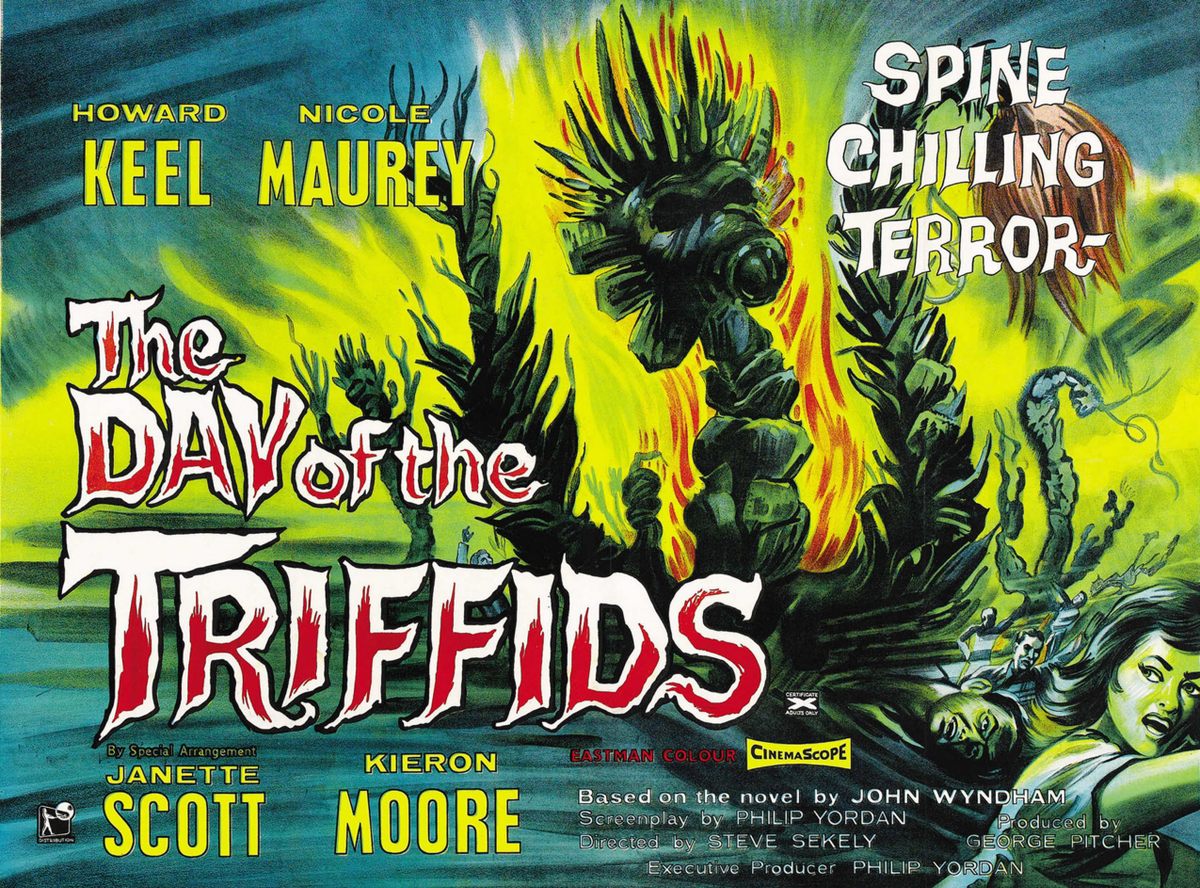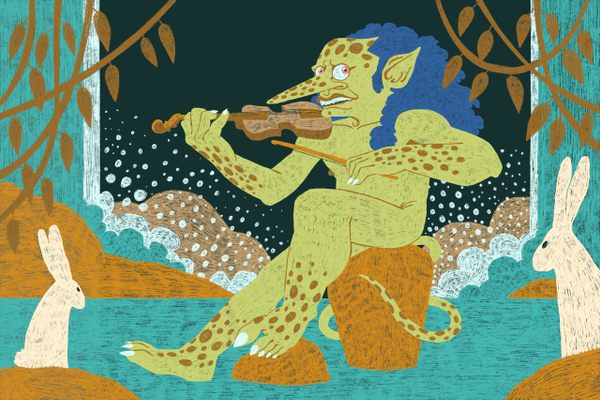What Stories of Scary Plants and Other Botanical Horrors Say About Us
From bloodthirsty orchids to body-snatching pods, fictional flora are often symbols of societal fears.
The peaks of a submerged mountain range poke through the surface of the Bay of Bengal, forming the 572 islands, islets, and rocks of the Andaman and Nicobar archipelagos. Officially, the islands are part of India, but they’re located nearly a thousand miles away. Their rugged rainforests are home to more than 150 species of orchids, from wild vanilla to the reddish-brown Erythrorchis altissima, which draws nutrients from decaying wood and leaves. But the most famous orchid from these islands might be one that never existed: a bloodthirsty bloom from H. G. Wells’s 1894 short story “The Flowering of the Strange Orchid.”
Like many real Andaman orchids that grow on tree branches, the titular strange orchid has roots exposed to the open air rather than buried in the soil. Unlike any real orchids, when Wells’s fictional flower blossoms, these aerial rootlets seek out human prey and attack with “leech-like suckers,” draining victims of their blood. As horror stories go, “The Flowering of the Strange Orchid” is pretty tame (the orchid collector’s housekeeper is able to rescue him from the plant’s clutches), but it’s an early example of a genre that’s been snaking its tendrils into people’s minds for more than a century: botanical horror. These tales of monstrous plants reveal deep-seated societal fears and shed light on people’s relationships with the natural world.
At first glance, plants might seem like unlikely candidates for monstrosity. They’re typically seen as symbols of life and growth. They’re often so unobtrusive that many people ignore them—and therein lies their potential for horror, says Dawn Keetley, a professor of English literature at Lehigh University. “If you’ve ever watched a horror film, the scary things always come from the closets and the dark corners,” she says. “Part of the horror of plants is that … we don’t expect a plant to be a threat.”
Of course, some plants are poisonous, and pose a real threat to humans who eat their fruit, touch their leaves, or even breathe the air nearby. Several species of “carnivorous” plants, often living in nutrient-poor environments, evolved to trap insect prey. Botanical horror, however, doesn’t tend to feature plants that exist in the natural world. Instead, the genre branches off into fantastical flora that actively seek out humans to consume, control, or otherwise conquer.

The emergence of scary plant stories appears to be a relatively recent phenomenon. Ancient myths and legends from around the world include stories of people being transformed into plants and vice versa, but generally aren’t intended to frighten. “At some point, modernity worked to erect barriers between humans and other non-human animals and definitely between plants,” says Keetley, adding that, when those divisions break down, “that’s when it starts being horrifying.”
One of the earliest instances of botanical horror, says Keetley, is explicit with this mixing of human and plant characteristics for a terrifying effect: the 1844 Nathaniel Hawthorne story “Rappaccini’s Daughter,” in which a woman who tends her scientist father’s garden of poisonous plants becomes poisonous herself.
As many Westerners’ everyday lives were increasingly separated from the natural world over the course of the 19th century, plants became more actively villainous in stories such as “The Flowering of the Strange Orchid.” Wells’s story is about more than a bloodsucking botanical nightmare, however: Its xenophobic colonial mindset uses the islands’ fearsome flora and fauna as a symbolic stand-in for the Indigenous people of the region.
This trope isn’t unique to Wells’s treatment of people from the Andaman Islands. “It seems like oftentimes anxieties about this new threat of Indigenous peoples gets projected onto the environment, so the environment itself becomes the threat rather than the Indigenous people,” says Kali Simmons (Oglala Lakota), a professor of Indigenous Nations Studies at Portland State University.
Villainous plants continued to crop up in stories in the 20th century, mirroring the societal fears du jour. For instance, the Red Scare saw a series of stories such as The Day of the Triffids (first a book in 1951, followed by a 1962 film) and Invasion of the Body Snatchers (1956), featuring monstrous plant life, from outer space or engineered by Soviet scientists, infiltrating human society. “It taps into the communist fear, and this is another thing that plants, I think, uniquely represent: We think they have no emotion,” says Keetley. “So they do kind of make a good stand-in for communists, the way people thought about communists in the ’50s, like they’re just some emotionless mass. not like people in the West who are expressive and emotional.”

In the past few decades, botanical horror has often dovetailed with the genre of ecohorror: Now, plants lash out in response to environmental destruction. Keetley points to the 2008 M. Night Shyamalan film The Happening and the 2006 book and subsequent movie The Ruins as examples of stories that “weave together the agency of vegetation, plants and trees, with the Earth itself, as forces that are going to basically kill us off, and that we probably deserve it.”
The more recent ecohorror genre, she suspects, taps into the root cause of all the botanical horror stories that have proliferated since the Industrial Revolution: a sneaking suspicion that, in spite of our lives being increasingly separate from the natural world, nature remains very much in control. “We’re afraid of nature, and we’re also guilty about what we’ve done to nature, and we’re pretty sure that because of what we’ve done to nature, it’s going to come back and bite us at some point,” Keetley says.
The uneasy relationship with the natural world that underlies botanical horror is far from universal. “I have yet to encounter an Indigenous story, contemporary or traditional, that has plant horror in it,” says Simmons, who studies Indigenous representation in horror.
Instead, she says, there is often a sense of interconnectedness, with animals and plants having the same “agency and sentience” that humans have. “So plants acting like a human being wouldn’t necessarily be terrifying, I think, for most Indigenous folks, because that’s just how plants are,” Simmons says. (She adds that some ecohorror works feature harmful depictions of Indigenous people: “I often see in those representations a sort of celebration of Native people, but also the continuous rendering of us as natural, part of the past, not part of civilization.”)
With the ongoing threats of habitat destruction and climate change, it’s unlikely that fears of nature’s wrath will disappear anytime soon, or that villainous vines and bad blooms will be pruned from the Western psyche. But there is a less adversarial option.
“In a lot of Indigenous horror, especially contemporary Indigenous horror, it’s rarely ever about killing the monster. It’s about all the other work that has to get done to make sure that people can live together,” says Simmons. “It becomes a matter of, okay, how do we go about restoring balance and honoring these relationships.”
Kaliyamurthy Karthigeyan, a senior researcher with the Botanical Survey of India who has spent more than two decades studying the orchids of the Andaman and Nicobar Islands—the real ones, not a single bloodsucker among them—thinks there are lessons all of us can learn from the Indigenous people Wells once disparaged.
“The Native people completely rely on nature … without disturbing [it],” Karthigeyan says of his experiences working with members of the Jarawa, Nicobarese, and Shompen communities there. Despite deforestation and other threats to their way of life, including pressure to assimilate, they are maintaining their cultural traditions, he says, adding, “Since they know that the resources are theirs and their future generations also need them, they use them responsibly.”

























Follow us on Twitter to get the latest on the world's hidden wonders.
Like us on Facebook to get the latest on the world's hidden wonders.
Follow us on Twitter Like us on Facebook